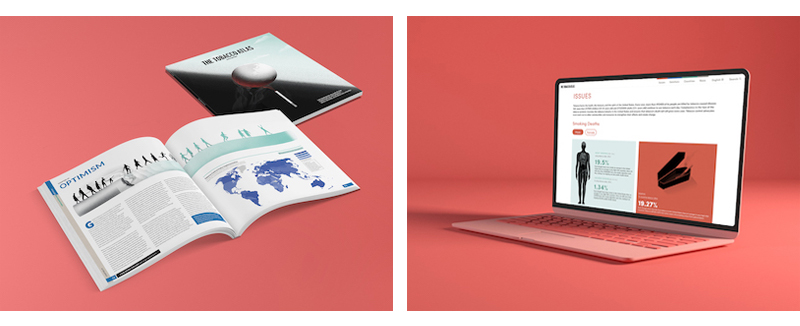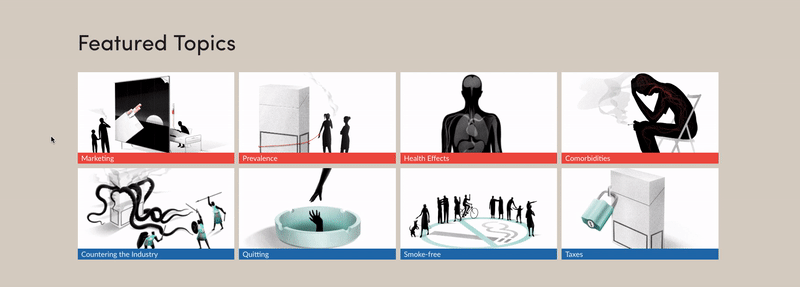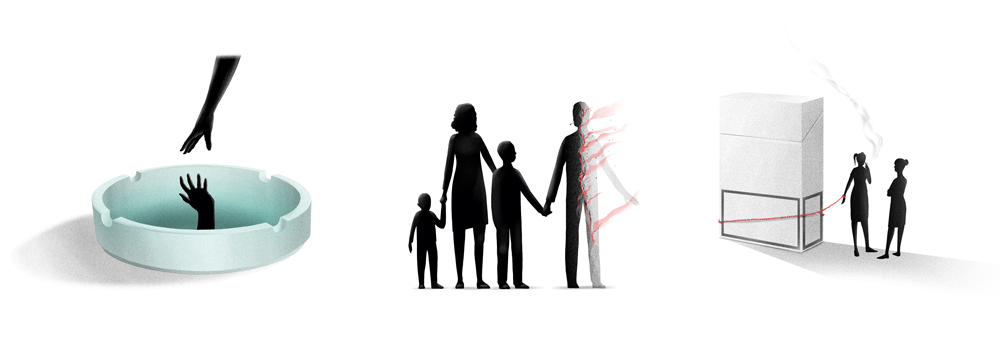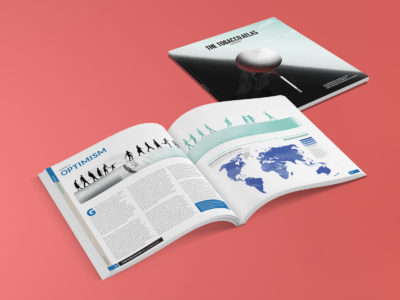
What happens when you get a project filled with a bunch of numbers and hard data?
You draw.
At least that’s what we did with the Tobacco Atlas, the publication we redesigned with the American Cancer Society and Vital Strategies. The report, which lives online and in print, showcases research on the epidemic’s salient issues as well as solutions to further a tobacco-free world.
When we pitched an illustration-heavy concept to the American Cancer Society and Vital Strategies teams, they were understandably wary. After five highly successful editions of the Atlas using photography and charts, it was hard to imagine what value, if any, illustration would bring to the sixth edition. What could artwork say about tobacco consumption that the data didn’t already show?


As it turns out (spoiler!), quite a lot. The striking imagery created by the talented Daniel Stolle shaped the visual language of the project, and gave a striking emotional depth to the dangers of tobacco. The custom illustrations captured the emotional underpinning of those numbers and graphs, interpreting the physiological and psychological toll of tobacco use in poignant, unexpected ways.

We used the illustrations to create a narrative flow for the 60-page report, dividing significant amounts of research data into digestible chapters. Readers knew what to expect from each section, and connected to the human elements of these issues through the story the illustrations told. In a somewhat counterintuitive turn of events, illustration became our most powerful tool for data-heavy storytelling.
Interview with the Illustrator: Daniel Stolle
Radish: How do you develop so many ideas around a single concept?
Daniel: To be honest it was quite a challenge… But because the Tobacco Atlas tries to shed light on all the aspects of tobacco, from farming to marketing, from personal health to effects on society, there is breadth in the subject, which allows for varied images.
Radish: Do you have a favorite illustration from the Atlas? Why?
Daniel: I like the cigarette ash dropping into the coffin. It is a simple image, that is quickly readable. On an emotional level the parent and child in front of the cigarette ad billboard hits closest to home for me. The presence of children makes you question your own behaviors. We are the ones that they look to, to explain the world to them and we realize how little we are guided by logic ourselves.

Radish: How do you tell a story through an image that will resonate with an international audience?
Daniel: That is a good question. I am aware that I come from a certain cultural background and have a certain bias. And for some of the illustrations, certain aspects that might not work universally. However, I hope that by approaching a subject not only conceptually but also on an emotional level, it is possible to find an image, that appeals to a basic human level, and works in many cultural contexts.
Radish: What do you think illustrations can offer for people who try to tell stories through data and research, who may not already be considering using illustrations or visuals at all?
Daniel: In addition to transcending cultural and geographic boundaries, I think illustrations can, in the best case, give data and facts a more approachable, human face…I consider illustration a very simple cultural technique – a person interpreting a certain, usually written, subject by drawing with pen on paper. I think the simplicity of the basic process allows us to give the subject another human touch and angle.
And there you have it; a BIG thank you to Daniel for his fantastic work and for talking to us about it!
If you ever find yourself on a data-heavy project without a vessel for the story, give illustration a chance to do the heavy lifting, and bring your facts and figures to life with true human emotion.
“We were a little skeptical about a publication anchored by illustrations, but Daniel Stolle has simply wowed us with his phenomenal vision and creativity. We are grateful for this new, wonderful twist to the Atlas.”
– Authors of the Tobacco Atlas, 6th Edition
